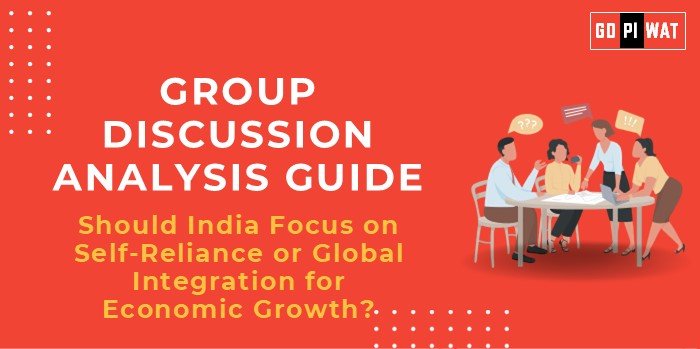📋 Group Discussion (GD) Analysis Guide: Should India Focus on Self-Reliance or Global Integration for Economic Growth?
🌐 Introduction to the Topic
- 📌 Opening Context: “In an era of globalization, nations grapple with the balance between self-reliance and global integration. For India, this balance is crucial to its economic trajectory.”
- 📌 Background: Post-independence, India adopted a protectionist stance, emphasizing self-reliance. Economic liberalization in 1991 marked a shift towards global integration. Recent initiatives like ‘Aatmanirbhar Bharat’ aim to bolster domestic industries while engaging globally.
📊 Quick Facts and Key Statistics
- 📈 GDP Growth (2023-24): India’s GDP grew by 6.7% year-over-year in the first quarter of fiscal 2024-25, aligning with projected growth rates.
- 💰 Foreign Direct Investment (FDI): India attracted over $70 billion in FDI during 2022-23, reflecting strong global investor confidence.
- 🚢 Exports: India’s merchandise exports in the fiscal year 2023-24 were $437.06 billion, a slight decline from $451.07 billion the previous year.
- 🏭 Manufacturing Contribution: The manufacturing sector contributed approximately 18% to India’s GDP in 2023, indicating growth potential.
- 📈 MSME Sector: Micro, Small, and Medium Enterprises (MSMEs) contribute about 30% to GDP and 48% to exports, underscoring their role in self-reliance.
🤝 Stakeholders and Their Roles
- 🏛️ Government of India: Formulates policies like Production Linked Incentive (PLI) schemes to promote domestic manufacturing and reduce import dependence.
- 💻 Private Sector: Drives innovation, enhances competitiveness, and forms global partnerships to integrate into international markets.
- 🌐 Global Organizations: Entities like the World Trade Organization (WTO) facilitate trade agreements and ensure fair trade practices.
- 👩💼 Citizens: Influence economic direction through consumption patterns and entrepreneurial ventures.
- 📚 Academia & Think Tanks: Provide research and policy recommendations to balance self-reliance with global integration.
🏆 Achievements and ⚠️ Challenges
Achievements
- 💼 PLI Schemes: Attracted investments of over ₹1.28 lakh crore as of May 2024, boosting domestic manufacturing.
- 🚢 Export Growth: India’s merchandise exports declined slightly by 3% in 2023, from $451 billion in the previous year to $437 billion.
- 💻 Tech Sector Expansion: IT and pharmaceutical sectors have positioned India as a global leader.
Challenges
- 📉 Import Dependence: High reliance on imports for crude oil and electronics affects trade balance.
- 📊 Trade Deficit: The trade deficit improved to $240.17 billion in 2023, down from $264.90 billion in the previous year.
- 🏗️ Infrastructure Gaps: Inadequate infrastructure hampers manufacturing growth and self-reliance efforts.
🌍 Global Comparisons
- 🇨🇳 China: Achieved manufacturing dominance through strategic global partnerships and domestic capacity building.
- 🇩🇪 Germany: Balances self-reliance with strong export orientation, leveraging advanced manufacturing.
📖 Case Studies
- 💉 Vaccine Production: India’s vaccine manufacturing during the COVID-19 pandemic showcased a blend of self-reliance and global collaboration.
- 📱 Electronics Manufacturing: PLI schemes in electronics led to significant investments, reducing import dependence.
💡 Structured Arguments for Discussion
- Supporting Self-Reliance: “Focusing on self-reliance enhances national security and economic resilience, as evidenced by the success of PLI schemes in boosting domestic manufacturing.”
- Supporting Global Integration: “Global integration facilitates technology transfer, access to larger markets, and foreign investments, driving economic growth.”
- Balanced Perspective: “A synergistic approach, combining self-reliance with global integration, enables India to build robust domestic industries while benefiting from global trade.”
🗣️ Effective Discussion Approaches
- 📊 Opening Approaches:
- Statistical Highlight: “With FDI inflows surpassing $70 billion in 2022-23, India stands at a crossroads between self-reliance and global integration.”
- Historical Context: “From protectionism post-independence to liberalization in 1991, India’s economic policies reflect an evolving balance between self-reliance and global integration.”
- Case Study Reference: “India’s vaccine production during the pandemic exemplifies the benefits of combining self-reliance with global collaboration.”
- 📌 Counter-Argument Handling:
- For Self-Reliance Critics: “While global integration offers benefits, over-dependence can expose vulnerabilities, as seen during global supply chain disruptions.”
- For Global Integration Skeptics: “Self-reliance without global engagement may limit access to advanced technologies and larger markets, hindering growth.”
📈 Strategic SWOT Analysis
- Strengths: Robust IT and pharmaceutical sectors, large domestic market, growing manufacturing capabilities.
- Weaknesses: Infrastructure deficiencies, dependence on imports for critical sectors, trade deficits.
- Opportunities: Global supply chain realignments, digital economy expansion, renewable energy investments.
- Threats: Geopolitical tensions, global economic slowdowns, protectionist policies by other nations.
🎓 Connecting with B-School Applications
- 🌍 Real-World Applications: Developing strategies for manufacturing growth, managing global supply chains, formulating policies for sustainable economic development.
- 📚 Sample Questions:
- “How can India balance self-reliance with the need for global integration in its economic policies?”
- “Discuss the role of PLI schemes in promoting self-reliance and their impact on India’s global trade relations.”
- 💡 Insights for Students: Explore the dynamics of global trade and its impact on domestic industries, analyze case studies of countries balancing self-reliance with global integration.
- 📂 Internship Perspective: Focus on sectors like supply chain management, public policy, and international trade during internships to understand how strategies for self-reliance or integration are executed.
- 📊 Project Ideas: Develop models to evaluate the impact of self-reliance initiatives, like PLI schemes, on India’s trade balance.


